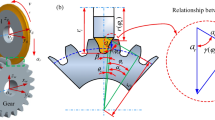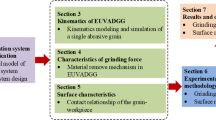Abstract
A tangential ultrasonic vibration-assisted gear grinding (TUVAGG) system was proposed in this paper to enhance the machining accuracy and performance of gears. Firstly, the longitudinal resonant vibration system of the TUVAGG was designed based on the non-resonant theory. The frequency equation and the displacement characteristics for the vibration system were obtained for the particular boundary conditions. Secondly, the vibration system composed of simplified disc and gear was simulated by the finite elements analysis method (FEM) and verified by the resonant measurement test. Finally, the vibration system effectiveness was verified through the ultrasonic vibration-assisted gear grinding test. The normal and tangential grinding forces in TUVAGG were lower by 7.4–28.2% and 8.9–18.9%, respectively, than conventional gear grinding (CGG). Besides, the grinding temperature and surface roughness in TUVAGG declined by 7.6–25.7% and 8.6–21.8% respectively compared with CGG, while the former tooth surface residual compressive stress and microhardness exceeded the latter ones by 13.2–29.3% and 8.9–12.7%. The non-resonant theory was suitable for the designation of longitudinal vibration system for TUVAGG, and also provided a novel process technology for gear machining.

















Similar content being viewed by others
Availability of data and material
All data generated or analyzed during this study are included in the present article.
Abbreviations
- TUVAGG:
-
Tangential ultrasonic vibration-assisted gear grinding
- CGG:
-
Conventional gear grinding
- v s :
-
Grinding wheel speed
- a r :
-
Radial grinding depth
- v w :
-
Gear feed rate
- l 1 :
-
Length of horn’s cylindrical section I
- l 2 :
-
Length of horn’s conical section II
- l 3 :
-
Length of horn’s cylindrical section III
- l 4 :
-
Length of horn’s cylindrical section IV
- R 1 :
-
Radius of horn’s cylindrical section I
- R 2 :
-
Radius of horn’s conical section II
- R 3 :
-
Radius of horn’s cylindrical section III
- R 4 :
-
Radius of horn’s cylindrical section IV
- R 5 :
-
Radius of horn’s cylindrical section V
- ξ 0 :
-
Maximal input displacement of the horn’s left end
- ξ 1 :
-
Displacement function of horn’s section I
- ξ 2 :
-
Displacement function of horn’s section II
- ξ 3 :
-
Displacement function of horn’s section III
- ξ 4 :
-
Displacement function of horn’s section IV
- ξ 5 :
-
Displacement function of horn’s section V
- k i :
-
Circular wave number of each section
- S i :
-
Cross-sectional area function
- a ij :
-
Coefficient of homogeneous equations
- C mn :
-
Coefficients of aij
- ρ i :
-
Material density
- λ :
-
Wavelength
- A :
-
Ultrasonic amplitude
- A A :
-
FEM-predicted amplitude
- A E :
-
Amplitude measured by the resonance test
- A M :
-
Amplitude of the theoretical analysis
- A AM :
-
Deviation between AA and AM values
- A EM :
-
Deviation between AE and AM values
- f :
-
Ultrasonic frequency
- f A :
-
FEM-predicted frequency
- f E :
-
Experimental resonance frequency
- f M :
-
Theoretical design frequency
- f AM :
-
Deviation between fA and fM values
- f EM :
-
Deviation between fE and fM values
References
Karpuschewski B, Knoche HJ, Hipke M (2008) Gear finishing by abrasive processes. CIRP Ann Manuf Techn 57(2):621–640
Bie WB, Zhao B, Wang XB, Chen F, Zhang YM (2018) Overview and expectation on gear anti-fatigue manufacture by ultrasonic-assisted machining. Surf Technol 47(7):35–51
Gupta K, Jain NK, Laubscher RF (2017) Advanced gear manufacturing and finishing: classical and modern processes, Academic Press, America.
Jiao F, Niu Y, Zhang MJ (2018) Prediction of machining dimension in laser heating and ultrasonic vibration composite assisted cutting of tungsten carbide. J Adv Manuf Syst 17(1):35–45
Yu T, Guo X, Wang Z, Xu P, Zhao J (2019) Effects of the ultrasonic vibration field on polishing process of nickel-basedalloy Inconel718. J Mater Process Technol 273:116228
Chen HF, Tang JY, Zhou W (2013) An experimental study of the effects of ultrasonic vibration on grinding surface roughness of C45 carbon steel. Int J Adv Manuf Technol 68(9-12):2095–2098
Öpöz TT, Chen X (2012) Experimental investigation of material removal mechanism in single grit grinding. Int J Mach Tools Manuf 63:32–40
Kitzig-Frank H, Tawakoli T, Azarhoushang B (2017) Material removal mechanism in ultrasonic-assisted grinding of Al2O3 by single-grain scratch test. Int J Adv Manuf Technol 91:2949–2962
Kumar J (2013) Ultrasonic machining-a comprehensive review. Mach Sci Technol 17(3):325–379
Kumabe J (1985) The foundation and application of precision vibration cutting. Machinery Industry Press, Beijing.
Wei BY, Deng XZ, Fang ZD (2007) Study on ultrasonic-assisted lapping of gears. Int J Mach Tools Manuf 47(12-13):2051–2056
Wang SY, Lü M, Ya G (2008) Research on system design of ultrasonic-assisted honing of gears. Adv Mater Res (53-54):191–196
Singh H, Jain PK (2018) Study on ultrasonic-assisted electrochemical honing of bevel gears. Proc Inst Mech Eng Part B: J Eng Manuf 232(4SI):705–712
Zhao B, Guo XC, Bie WB, Chang BQ, Zhao CY (2020) Thermo-mechanical coupling effect on surface residual stress during ultrasonic vibration-assisted forming grinding gear. J Manuf Process 59:19–32
Wei BY, Deng XZ, Yang JJ (2007) Design and experiments of transducer-horn of ultrasonic lapping of gears. Tech Acoust 26(4):767–770
Wu NS, Deng XZ, Yang JJ (2008) Design and study of amplitude transformer horn in the ultrasonic lapping system of hypoid gear. J Mech Transm 32(2):16–17
Gong XQ, Xing RF (2009) Design of ultrasonic gear-honing vibration system based on four-terminal network method. New Technol New Process (7):60–62
Lü M, She YZ, Qin HB (2013) Design method for a vibration system of ultrasonic gear honing and its dynamic characteristics. J Vib Shock 32(2):147–152
Zhao B (1999) Study on ultrasonic honing system and feature of ductile domain cutting of hard-brittle materials. Ph. D. Thesis, Shanghai Jiao Tong University.
Lü M, Wang SY, Qin HB (2014) Nonresonantdesign theory and ultrasonic gear machining. Science Press, Beijing.
She YZ, Lü M, Wang SY (2012) Design of transformer with non-resonance structure and its dynamic study. Chin J Mech Eng 48(7):49–55
Lin ZM (1987) Principle and design of ultrasonic horn. Science Press, Beijing.
Wang SY, Lü M, Ya G (2008) Study on dynamical characteristics of transformer with non-resonance annular plate and horn. Acta Acustica 33(5):462–468
Zhang HL (2007) Study on the technology and mechanism of ultrasonic vibration assisted grinding. Ph. D. Thesis, Shandong University.
Ding K, Fu YC, Su HH, Cui FF, Li QL (2017) Experimental studies on matching performance of grinding and vibration parameters in ultrasonic assisted grinding of SiC ceramics. Int J Adv Manuf Technol 88(9-12):2527–2535
Thakur A, Gangopadhyay S (2016) State-of-the-art in surface integrity in machining of nickel-based super alloys. Int J Mach Tools Manuf 100:25–54
Funding
This work was financially supported by the National Natural Science Foundation of China (Nos. U1604255 and 51905157).
Author information
Authors and Affiliations
Contributions
Wenbo Bie conceived the analysis and wrote the manuscript. Bo Zhao provided supervisions on experimentation and manuscript preparation. Chongyang Zhao collected the data and revised the manuscript. Long Yin and Xingchen Guo performed the experiment. The authors discussed each reference paper together and contributed useful ideas for this manuscript.
Corresponding author
Ethics declarations
Ethical approval
The article follows the guidelines of the Committee on Publication Ethics (COPE) and involves no studies on human or animal subjects.
Consent to participate
Not applicable.
Consent to publish
Not applicable.
Competing interests
The authors declare no competing interests.
Additional information
Publisher’s note
Springer Nature remains neutral with regard to jurisdictional claims in published maps and institutional affiliations.
Rights and permissions
About this article
Cite this article
Bie, W., Zhao, B., Zhao, C. et al. System design and experimental research on the tangential ultrasonic vibration-assisted grinding gear. Int J Adv Manuf Technol 116, 597–610 (2021). https://doi.org/10.1007/s00170-021-07459-8
Received:
Accepted:
Published:
Issue Date:
DOI: https://doi.org/10.1007/s00170-021-07459-8




